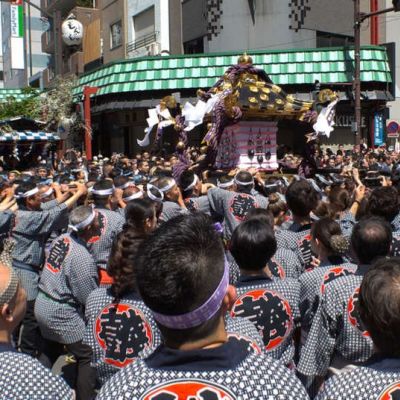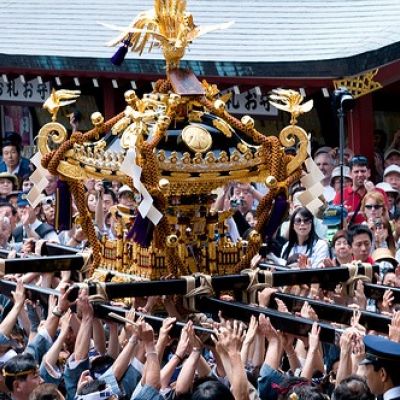Sanja Festival (三社祭, Sanja Matsuri) is an annual celebration in the Asakusa neighborhood that normally takes place during the third full weekend in May. It commemorates Sensoji Temple’s three founders, who are enshrined at Asakusa Shrine near to the temple. Over three days, about two million people attend Asakusa, making it one of Tokyo’s most popular festivals.
History
Sanja Matsuri, like many other Japanese festivals, is a religious event. It is a weekend-long Shinto celebration honoring the kami (spirits) of three men. On March 18, 628, two fishermen, Hinokuma Hamanari and Hinokuma Takenari, are said to have discovered a figurine of the Bodhisattva Kannon trapped in a fishing net in the Sumida River early that morning. The third guy, a rich landowner called Hajino Nakatomo, learned about the finding and contacted the brothers, converting them to Buddhism. The three guys subsequently committed their lives to Buddhism and dedicated the statue to a tiny temple. Sensō-ji, Tokyo’s oldest temple, presently houses the Kannon statue.
The Sanja Matsuri seems to have several forms dating back to the 7th century, as well as many names, including “Kannon Matsuri” and “Asakusa Matsuri.” Sanja Matsuri’s current shape was formed during the Edo era. In 1649, shōgun Tokugawa Iemitsu ordered the building of Asakusa Shrine, a Shinto shrine honoring the three kami. The presence of this shrine contributed to the festival’s prominence, as well as its present structure and organization.

What Happens During The Sanja Matsuri Festival?
This is one of Tokyo’s rowdiest events. Approximately two million people often go to witness fairly enthusiastic, occasionally tattooed guys engage in what can best be characterized as “mikoshi jousting.” Whereas at other festivals, mikoshi (portable shrine) carriers may bounce the very heavy mikoshi, during the Sanja Matsuri, fundoshi-clad (similar to a loin cloth) participants often ride on top and attempt to knock opponents off — even though this is technically banned.
Smaller local mikoshi may be seen on Asakusa’s streets throughout the festival, but the festival’s main attraction, three giant mikoshi belonging to Asakusa Shrine, appears on Sunday. Asakusa is filled with food booths, festival activities, and revelers throughout the festival, with Japanese drums and flutes adding to the vibrant mood.
When Is Sanja Matsuri Festival Celebrated
May 17 (Friday)
At 13:00, a parade with dancers and traditional floats will take place. The tour will begin immediately north of Sensōji Temple and go via Asakusa Station (Tsukuba Exp.) to Asakusa Shrine via Nakamise Street. At 14:20: A unique dance will be performed at Asakusa Shrine to honor the procession’s arrival.
May 18 (Saturday)
From noon, local mikoshi will be marched from Asakusa Shrine. A shrine lady dance performance is scheduled at 16:00.
May 19 (Sunday)
From 08:00-20:00, the mikoshi will march around Asakusa and the temple. If you want to acquire a decent place, attempt to make sense of the route maps available on the website. From 14:00 to 16:00, Asakusa Shrine will include shrine maiden dance and drum performances.

Navigating Your Way to the Sanja Matsuri: Transportation Guide
The Sanja Matsuri takes place in and around the grounds of Asakusa Shrine and Sensoji Temple, a short distance from Asakusa Station, which is serviced by the Ginza Subway Line, Asakusa Subway Line, and Tobu Railway.
From Tokyo Station:
- Take the JR Yamanote Line to Kanda station. The trip takes around two minutes and costs 150 yen.
- At Kanda Station, transfer to the Ginza Subway Line to Asakusa.
- Take the Ginza Subway Line for around ten minutes till you reach Asakusa Station.
- Once reaching Asakusa Station, follow the signs to Asakusa Shrine and Sensoji Temple, which are just a few feet away.
From Shinjuku Station:
- Take the orange JR Chuo Line to Kanda Station. The trip lasts around ten minutes and costs 180 yen.
- At Kanda Station, transfer to the Ginza Subway Line and travel towards Asakusa.
- Take the Ginza Subway Line for around ten minutes till you reach Asakusa Station.
- Follow the indications from Asakusa Station to reach Asakusa Shrine and Sensoji Temple, which are adjacent.
